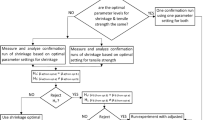Abstract
In this study, a numerical investigation of warpage found within insert injection-molded frame parts was carried out based on the Taguchi method in conjunction with a response surface methodology. An integrated mold frame unit was recently developed by integrating a conventional mold frame, metal reflector, and bezel together, to be used in a back light unit system of a liquid crystal display. Such an integrated plastic-metal hybrid part could be successfully manufactured through the insert injection molding process. However, minimization or even elimination of warpage, one of the severe defects found in injection-molded products, is required for reliable mass production. Therefore, a numerical analysis was performed to reveal the effects of the relevant processing parameters, showing that packing pressure played the most significant role, originated from temperature difference between corners of the final product. Furthermore, a double optimization process combining the Taguchi method and the response surface methodology was employed to determine accurate and optimal processing conditions. The results clearly verified that the current combination technique can overcome the Taguchi method’s limitation, resulted from a discrete optimization nature, and also effectively give more accurate optimum solutions without complicated algorithms and software.
Similar content being viewed by others
References
Chiang, Y.-C., Cheng, H.-C., Huang, C.-F., Lee, J.-L., Lin, Y., and Shen, Y.-K., “Warpage Phenomenon of Thin-Wall Injection Molding,” The International Journal of Advanced Manufacturing Technology, Vol. 55, Nos. 5-8, pp. 517–526, 2011.
Lin, C. C., “Influence of Injection Velocity and Joint Geometry on Quality of Insert Molding,” Polymer Engineering & Science, Vol. 52, No. 2, pp. 268–276, 2012.
Jin, K., Jeong, T., Kim, T., Kim, N., and Kim, B., “Analysis and Design for Reducing Residual Stress and Distortion after Ejection of Injection Molded Part with Metal-Insert,” Int. J. Precis. Eng. Manuf., Vol. 15, No. 12, pp. 2533–2542, 2014.
La, M., Park, S. M., Kim, W., Lee, C., Kim, C., and Kim, D. S., “Injection Molded Plastic Lens for Relay Lens System and Optical Imaging Probe,” Int. J. Precis. Eng. Manuf., Vol. 16, No. 8, pp. 1801–1808, 2015.
Ozcelik, B. and Sonat, I., “Warpage and Structural Analysis of Thin Shell Plastic in the Plastic Injection Molding,” Materials & Design, Vol. 30, No. 2, pp. 367–375, 2009.
Azaman, M. D., Sapuan, S. M., Sulaiman, S., Zainudin, E. S., and Khalina, A., “Optimization and Numerical Simulation Analysis for Molded Thin-Walled Parts Fabricated Using Wood-Filled Polypropylene Composites via Plastic Injection Molding,” Polymer Engineering & Science, Vol. 55, No. 5, pp. 1082–1095, 2015.
Wang, X., Zhao, G., and Wang, G., “Research on the Reduction of Sink Mark and Warpage of the Molded Part in Rapid Heat Cycle Molding Process,” Materials & Design, Vol. 47, pp. 779–792, 2013.
Zafošnik, B., Božič, U., and Florjanič, B., “Modelling of an Analytical Equation for Predicting Maximum Stress in an Injections Moulded Undercut Geometry During Ejection,” Int. J. Precis. Eng. Manuf., Vol. 16, No. 12, pp. 2499–2507, 2015.
Chen, P.-C., Chen, Y.-C., Pan, C.-W., and Li, K.-M., “Parameter Optimization of Micromilling Brass Mold Inserts for Microchannels with Taguchi Method,” Int. J. Precis. Eng. Manuf., Vol. 16, No. 4, pp. 647–651, 2015.
Zheng, G., Guo, W., Wang, Q., and Guo, X., “Influence of Processing Parameters on Warpage according to the Taguchi Experiment,” Journal of Mechanical Science and Technology, Vol. 29, No. 10, pp. 4153–4158, 2015.
Kurtaran, H. and Erzurumlu, T., “Efficient Warpage Optimization of Thin Shell Plastic Parts using Response Surface Methodology and Genetic Algorithm,” The International Journal of Advanced Manufacturing Technology, Vol. 27, Nos. 5-6, pp. 468–472, 2006.
Park, H.-S. and Dang, X.-P., “Optimization of Conformal Cooling Channels with Array of Baffles for Plastic Injection Mold,” Int. J. Precis. Eng. Manuf., Vol. 11, No. 6, pp. 879–890, 2010.
Li, X.-P., Zhao, G.-Q., Guan, Y.-J., and Ma, M.-X., “Optimal Design of Heating Channels for Rapid Heating Cycle Injection Mold Based on Response Surface and Genetic Algorithm,” Materials & Design, Vol. 30, No. 10, pp. 4317–4323, 2009.
Chen, W.-L., Huang, C.-Y., and Hung, C.-W., “Optimization of Plastic Injection Molding Process by Dual Response Surface Method with Non-Linear Programming,” Engineering Computations, Vol. 27, No. 8, pp. 951–966, 2010.
Nian, S.-C., Wu, C.-Y., and Huang, M.-S., “Warpage Control of Thin-Walled Injection Molding using Local Mold Temperatures,” International Communications in Heat and Mass Transfer, Vol. 61, pp. 102–110, 2015.
Chen, W.-C. and Kurniawan, D., “Process Parameters Optimization for Multiple Quality Characteristics in Plastic Injection Molding using Taguchi Method, BPNN, GA, and Hybrid PSO-GA,” Int. J. Precis. Eng. Manuf., Vol. 15, No. 8, pp. 1583–1593, 2014.
Xu, G. and Yang, Z., “Multiobjective Optimization of Process Parameters for Plastic Injection Molding via Soft Computing and Grey Correlation Analysis,” The International Journal of Advanced Manufacturing Technology, Vol. 78, Nos. 1-4, pp. 525–536, 2015.
Fan, B. and Kazmer, D., “Effect of Low Temperature Shift Factor Modeling on Predicted Part Quality,” Proc. of ANTEC Conference Proceedings, pp. 938–942, 2003.
Park, J. M., Jeong, S. J., and Park, S. J., “Numerical Prediction of Flake Orientation and Surface Color in Injection Molding of Flake-Pigmented Thermoplastics,” Polymer Composites, Vol. 32, No. 8, pp. 1297–1303, 2011.
Lee, B.-K., Hwang, C. J., Kim, D. S., and Kwon, T. H., “Replication Quality of Flow-Through Microfilters in Microfluidic Lab-on-a-Chip for Blood Typing by Microinjection Molding,” Journal of Manufacturing Science and Engineering, Vol. 130, No. 2, Paper No. 021010, 2008.
Myers, R. H., Montgomery, D. C., and Anderson-Cook, C. M., “Response Surface Methodology: Process and Product Optimization Using Designed Experiments,” Wiley, 3rd Ed., pp. 866–878, 2009.
Author information
Authors and Affiliations
Corresponding author
Rights and permissions
About this article
Cite this article
Nguyen, T.K., Hwang, C.J. & Lee, BK. Numerical investigation of warpage in insert injection-molded lightweight hybrid products. Int. J. Precis. Eng. Manuf. 18, 187–195 (2017). https://doi.org/10.1007/s12541-017-0024-5
Received:
Revised:
Accepted:
Published:
Issue Date:
DOI: https://doi.org/10.1007/s12541-017-0024-5




